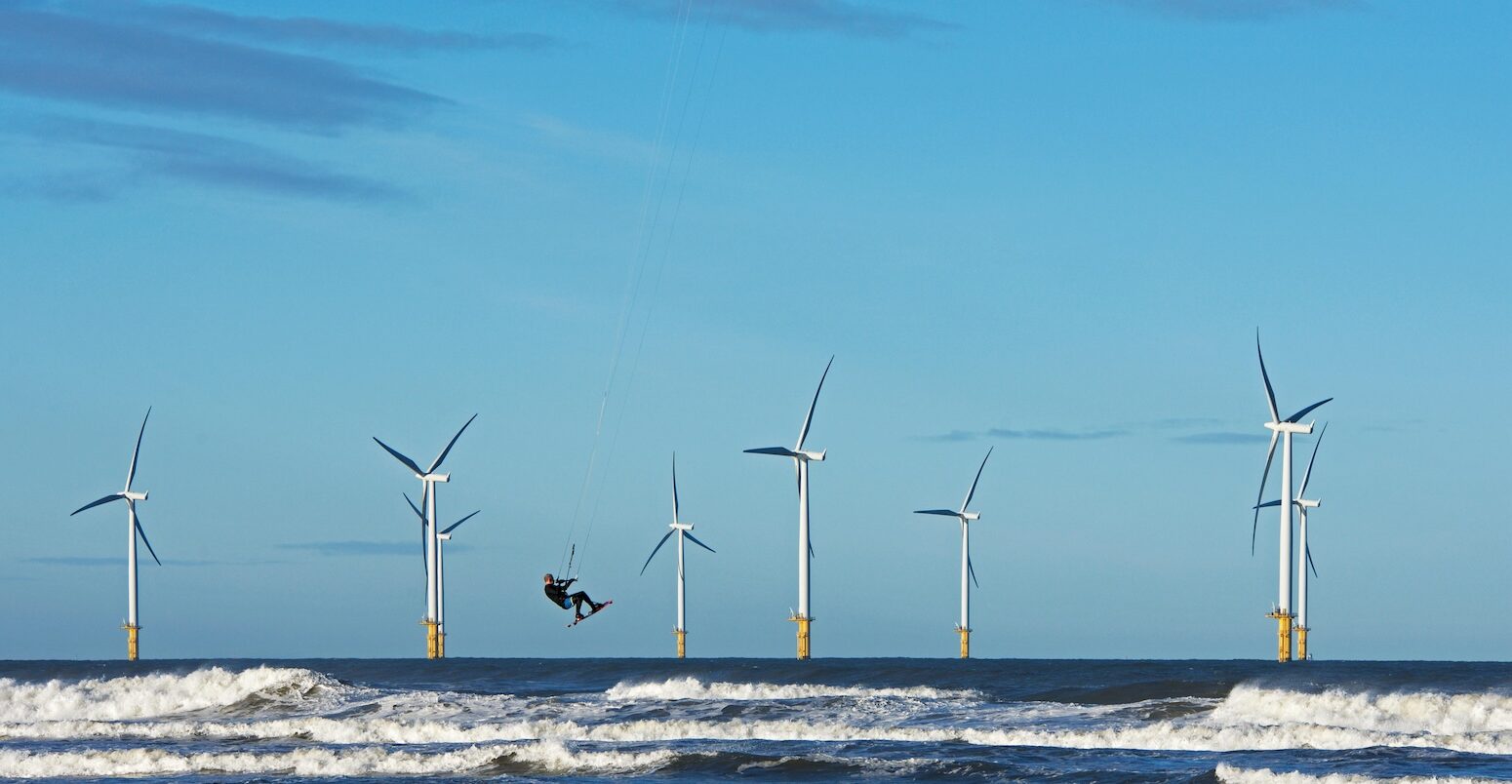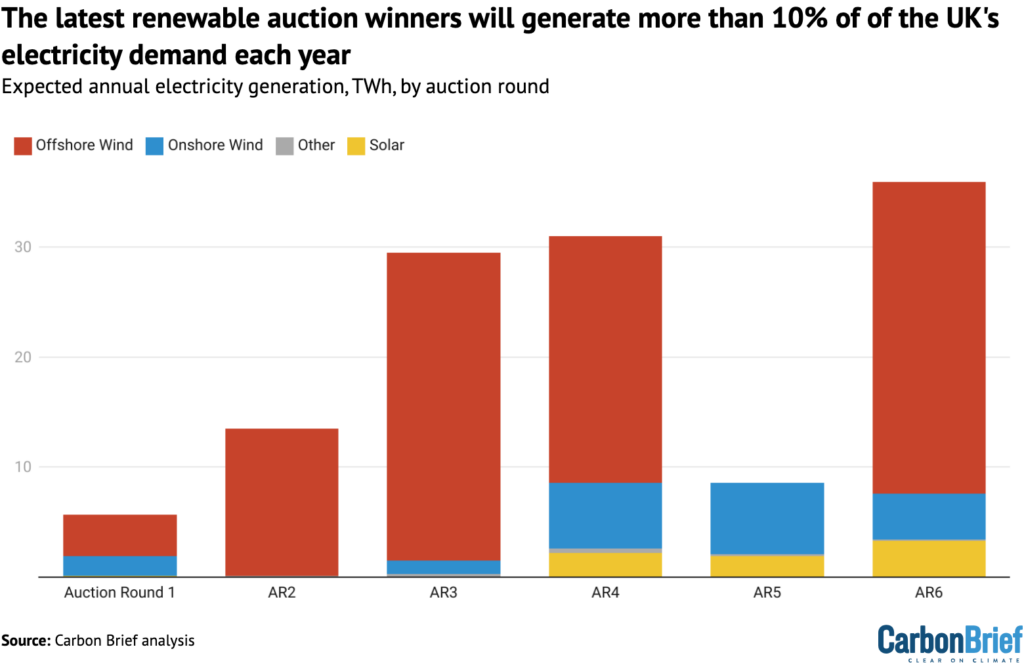
Analysis: UK’s record-breaking renewable auction ‘will cut consumer bills’
Multiple Authors
09.04.24Multiple Authors
04.09.2024 | 3:53pmA record number of projects have been secured in the UK’s latest auction for new renewable capacity, following changes introduced by the government.
More than 130 wind, solar and tidal energy projects secured funding in the latest round of the “contracts for difference” (CfD) scheme, amounting to 9.6 gigawatts (GW) of capacity.
This is three times higher than the amount secured last year. It is also a new capacity record, if wind power projects from 2022 that were subsequently cancelled or scaled back are excluded.
The auction comes after last year’s failure to contract any new offshore wind projects. This year, 4.9GW of offshore wind was confirmed, as well as one 400MW floating offshore wind project, which will be the world’s largest when built.
Contrary to misleading newspaper reports, one analyst told Carbon Brief the schemes would cut consumer bills by “increasing the availability of cheap, low-carbon power”.
However, the energy sector has warned that a “big step-up” will be required in order to build enough renewables for the new Labour government’s target of a clean power system by 2030.
Previous analysis from industry group Energy UK shows achieving this target would need an unprecedented fourfold increase in offshore wind capacity being approved at next year’s auction.
Return of offshore wind
The government’s CfD scheme offers fixed-price contracts to low-carbon electricity generators via a “reverse auction” process, which is now held annually.
Projects bid against each other to secure contracts for the electricity they will generate. The winning bidders get a CfD to sell electricity at a fixed “strike price”.
If the market pays less than this amount, a levy is added to bills to make up the difference – and if market prices are higher, then the project pays the difference back to consumers.
Last year’s fifth allocation round (AR5) saw no offshore wind projects awarded contracts for the first time since the CfD scheme was introduced in 2015.
Just 3.7GW of total renewables capacity was secured, which was mainly made up of solar (1.9GW) and onshore wind (1.7GW).
That result had followed significant economic pressures in the industry due to higher commodity prices, supply chain constraints and higher borrowing costs.
According to the International Energy Agency (IEA), offshore wind investment costs rose 20% last year, even before taking into account the increase in interest rates. It cited one offshore wind project in the UK that had been cancelled after overall costs rose by 40%.
This was the Norfolk Boreas windfarm, which had won a contract in the 2022 auction.
In order to avoid repeating last year’s failure on offshore wind, numerous changes were made ahead of this year’s auction. This included restoring offshore wind to a separate funding “pot”, rather than combining it with solar and onshore wind.
More importantly, the “budget” for the auction was raised significantly in November 2023 and the price cap for offshore wind was increased by 66%, from £44 per megawatt hours (MWh) to £73/MWh. (Note that CfD auctions are reported in 2012 prices.)
Beyond offshore wind, price caps were also raised for other technologies, including solar by 30% (from £47/MWh to £61/MWh), geothermal by 32% (from £119/MWh to £157/MWh) and tidal by 29% (from £202/MWh to £261/MWh).
Subsequently, in late July the newly elected Labour government again raised the CfD auction “budget”. This brought the final overall “budget” for the sixth allocation round (AR6) to £1.56bn, an increase of £530m on AR5.
(Note that the “budget” is a notional limit on the amount of CfD levies that can be added to consumer electricity bills. It does not come from government coffers and does not translate directly into an equivalent increase in consumer costs, because CfD projects also reduce wholesale electricity prices, which make up the bulk of bills.)
Within the increased “budget” was an extra £65m for “pot 1” technologies, mainly solar and onshore wind, and £165m for “pot 2” for technologies such as floating offshore wind. There was also an extra £300m for “pot 3”, meaning fixed-foundation offshore wind projects could bid up to a total of £1.1bn.
Additionally, one significant change was the allowance of “permitted reduction” projects in AR6.
Under permitted reduction, up to 25% of the capacity from a project that has previously been awarded a CfD can be withdrawn, with the option of submitting it again at future auctions.
Following these changes to the auction framework, AR6 secured 9.6GW of capacity, across a record 131 projects. This represents a threefold increase from the previous auction round. As the chart below shows, once the 2022 projects that have since been withdrawn are excluded it also represents a record amount of renewable capacity.

The 9.6GW of capacity secured in the auction includes 3.4GW of new-build offshore wind, at a strike price of £58.87/MWh. This was across two projects, Ørsted’s Hornsea Project 4 (2.4GW) and ScottishPower’s East Anglia 2 (1.0GW).
Additionally, 1.6GW of previously submitted offshore capacity was awarded contracts as part of the “permitted reduction” process. This was split across seven projects, which secured a strike price of £54.23/MWh.
The “permitted reduction” process was introduced, in part, due to around 3GW of offshore wind projects – including the Norfolk Boreas windfarm – which won contracts in allocation round 4 (AR4) in 2022 subsequently being cancelled or reduced in size.
Anticipating the “permitted reduction” process in December 2023, global wind giant Ørsted had announced a final investment decision for the 2.9GW Hornsea 3.
It had initially secured a CfD in 2022 at a strike price of £37.35/MWh. In this year’s auction Hornsea 3 secured a CfD for the share resubmitted at £54.23/MWh.
Writing on LinkedIn, Alex Asher, consultant at Cornwall Insight noted the scale and value of the permitted reduction in pot 3. He wrote:
“Around a third of the capacity, 1.5GW, coming from permitted reductions is significant, and a £4/MWh lower price can be seen as a potential win for consumers, but can also be seen as a high price for assets which already have a certain amount of development covered. It will be interesting to see how permitted reductions are used in AR7 and beyond.”
The auction also secured 3.3GW of solar capacity across 93 projects and 1.0GW of onshore wind across 22 projects. This includes one onshore wind project in England, where the technology had been effectively “banned” for years under the previous Conservative government
Collectively, these three technologies were awarded contracts at over 18% below their “administrative strike prices” – the maximum price that developers can bid into the auction. According to consultants Aurora Energy this reflects“strong market engagement” with the auction, resulting in increased competition between bidders.
The auction also resulted in a contract for the largest floating offshore wind project in the world, the 0.4GW GreenVolt scheme, which secured a strike price of £139.93/MWh. The project is double the size of Europe’s total installed floating offshore wind capacity.
Six tidal projects, with a total capacity of 28 megawatts (MW), secured contracts with a strike price of £172/MWh. The government says this is “building on the UK’s world leading position, with just under half of the world’s operational tidal stream capacity being situated in UK waters”.
Once built, these projects are expected to generate some 36 terawatt hours (TWh) of electricity each year – more than 10% of the UK’s current demand, as shown in the figure below. This is equivalent to 1.5 times the expected output of the Hinkley C new nuclear plant, which is under construction and now due to come online in 2031.
In total, the renewable projects contracted in the first six CfD auction rounds will generate nearly 125TWh per year by 2029, nearly half of current UK demand.

Changing prices
Despite continued increases in strike prices in the CfD from the record lows seen in 2022, renewables remain some of the UK’s cheapest ways to source new electricity generation.
In addition, all of the renewable contracts were awarded at below the technology-specific price caps in this year’s auction.
This means that of the £1.56bn “budget” for the auction, around £1.29bn was allocated, according to Cornwall Insight.
Speaking to Carbon Brief, Martin Young, industry consultant at Aquaicity says the estimated budget impact for offshore wind is £870m, compared to the £1.11bn on offer. For “emerging technologies” in funding pot 2, the estimated budget impact of the contracts awarded is £228m out of the £275m that was on offer.
Young adds:
“Applications received for each pot were above budgets for each pot, suggesting that there were unsuccessful projects seeking higher strike prices that could not be accommodated with the budget structures of each pot.”
The majority of these unsuccessful projects were offshore wind.
Offshore wind strike prices this year were £54/MWh – some 46% above the record-low £37/MWh seen in 2022, which came before the sharp increase in costs linked to the global energy crisis and rising interest rates.
Solar prices also increased to £50MWh, up from £46/MWh in 2022 and £47/MWh in 2023. Onshore wind, meanwhile, cleared at £51/MWh, slightly below the £52/MWh achieved in 2023 but well above the £42/MWh seen in 2022.
Earlier this year, Cornwall Insight predicted that wholesale electricity prices – a proxy for the cost to fuel and operate an already-built gas-fired power station – would sit at £82/MWh on average for 2024/25, and £84/MWh for 2025/26.
According to Aurora Energy Research, wholesale prices averaged £93/MWh in 2023 and £64/MWh in 2024 to date.
CfD contracts are expressed in 2012 prices, but even when adjusted for inflation new-build offshore wind, onshore wind, and solar are £82/MWh, £71/MWh and £70/MWh in today’s money.
While this year’s clearing strike prices may sit slightly above wholesale electricity prices for 2024, the comparison between wholesale power prices for 2024 and the prices awarded to CfD projects is “slightly deceptive” as Pranav Menon, research associate at Aurora explains to Carbon Brief.
Crucially, Menon says that the projects secured by the auction will reduce bills. He says:
“Ultimately, the cost of the CfD contracts awarded will depend on how prices look in the years these assets are operational and subsidised, ie between 2026 and 2045. Overall, given that wholesale prices are expected to drop as more intermittent renewables connect to the grid, we do expect the total cost of AR6 contracts to be higher than present market prices imply.
“However, deploying this capacity ultimately lowers costs to consumers by increasing the availability of cheap, low-carbon power and is key to reducing power sector emissions.”
Menon’s analysis directly contradicts misleading coverage in the Daily Telegraph and the Daily Mail, both of which reported that the auction would increase bills.
The Mail said that the new renewable projects secured in the auction would add £50 to bills, citing free-market thinktank the Institute of Economic Affairs and climate-sceptic lobby group Net Zero Watch. These groups, in turn, relied on a blog written by a retired IT consultant months before the auction result was announced.
In an article trailed on the newspaper’s frontpage and quoting John Constable, the “energy editor” of Net Zero Watch’s parent organisation the Global Warming Policy Foundation, the Daily Telegraph said the auction would add £150 to bills.
Both newspapers’ figures are wrong because, among a string of errors, they assume that the auction “budget” translates directly into an impact on consumer bills. This is incorrect.
Consumer bills are made up of wholesale electricity costs, levies to support CfDs and other government policies, as well as a number of other factors. While CfD projects directly affect levies, they also indirectly reduce wholesale prices.
Adam Bell, director of policy at consultancy Stonehaven tells Carbon Brief that looking at the CfD “budget” alone is not a meaningful way to calculate the impact on bills. He explains:
“The only meaningful comparison is between a system that has those additional [wind and solar] projects and a system that does not. So you add the cost of CfD payments and subtract lower wholesale prices that arise from having more zero marginal cost generation.”
Overall, analysis from Aurora shows that bills are likely to be lower if the UK reaches the government’s 2030 target for clean electricity by building more wind and solar projects, than if it continues to rely on larger amounts of more expensive and volatile gas-fired power.
Indeed, wholesale power prices are predicted to stay above £80/MWh on average out to 2030, according to Cornwall Insight, meaning the newly contracted schemes will generate power at or below expected wholesale prices by the time they start operating.
‘Big step-up’ needed
After last year’s failure to secure any new offshore wind capacity, trade body Energy UK warned of “serious risks” that the then-Conservative government would be unable to meet its goal of reaching 50GW of offshore wind capacity by 2030.
Since then, there has been an election and a new Labour government, with a more ambitious target of a net-zero power system by 2030. This includes a new goal of deploying 55GW of conventional offshore wind by 2030, plus 5GW of floating offshore wind.
There is currently 15GW of conventional offshore wind capacity operating in the UK. This would need to increase by more than 3.5 times over the next six years to meet the new target.
It takes several years for a project to move from auction to the point at which it is generating electricity. This means that the auctions this year and next year are viewed by Energy UK as the final ones at which projects can realistically be secured in time for the 2030 target.
Labour’s revised CfD budget increased the amount of offshore wind capacity secured this year, with 4.9GW contracted as well as 400MW of floating offshore wind.
However, Energy UK analysis in July concluded that the upcoming two auctions – this year and next year – “must deliver 26GW of new capacity”. This means next year’s auction would now need to secure 21GW of conventional offshore wind capacity to hit the 2030 goal.
Previously, the trade body had stated that it would be “unrealistic to expect that 21GW could be achieved from just one CfD auction round”. It pointed to practical issues such as supply chain constraints and the availability of skilled workers.
As the chart below shows, reaching this level would require an unprecedented fourfold increase in offshore wind capacity secured in a single auction.

While the expert commentary on the new auction results was broadly positive, some of it also reflected these concerns about next year’s auction.
Aurora’s Menon said in an emailed statement that “more progress is essential” to meet the 60GW goal, as next year “will be the final opportunity to secure the remaining capacity needed”.
Meanwhile, Dan McGrail, chief executive of the trade body RenewableUK, said in a statement:
“The government has set a world-leading clean power mission for 2030 and to meet that will need a big step-up from today.”
-
Analysis: UK’s record-breaking renewable auction ‘will cut consumer bills’




